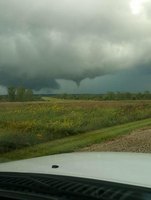Roofing Kansas City: How to Make Your Roof Tornado Proof

Tornadoes are the biggest threat to houses and pose the greatest danger to homeowners in the United States. They pack wind strengths with up to four times more destructive power than hurricanes and earthquakes. Normal housing construction methods are generally inadequate to resist the devastation brought by the strong winds of tornadoes, but it is not difficult to fortify your house against this destructive force of nature.
Every time a tornado hits, the first thing that goes off a house is the roof. A tornado exerts upward pressure against the roof and either inward or outward pressure against the walls. Once the roof lifts off it will leave the walls weak and unstable because the lateral stability provided by the roof is gone. That is why the importance of reinforcing your roof cannot be overemphasized.
Of course, different roofing Kansas City materials have distinct durability and toughness. Wood-framed houses are admittedly weaker compared to concrete buildings.
Reinforced Concrete Roof Decks
The roof systems that have been observed to consistently withstand tornadoes and hurricanes are those constructed with structural reinforced concrete decks, which are similarly connected to structural reinforced concrete walls.
Concrete walls are required to be reinforced to withstand the horizontal and vertical pressures of the wind as it beats on the roof. These walls are referred to as shear or bearing walls. For the entire structure or building to become fully resistant to the destructive winds, the roof structure must act as a solid and dependable structural diaphragm.
Reinforcing Non-Concrete Roof Decks
If you have a roof other than concrete decks, there are variety of ways to reinforce it and increase its resistance against the strong winds brought by tornadoes. One solution is to use hurricane clips on the roof. The clips attach the trusses or rafters to the top plate, thereby strengthening the link between the two parts. The reinforcement of the connection is amplified and could withstand far greater wind pull compared to the typical connection used on houses, which is a toenail hammered at an angle that lacks the protection provided by the hurricane clips.
Depending on the clips used, hurricane clips provide uplift protection from 400 to 1500 pounds or possibly more. In ordinary areas, a clip designed for uplift protection of 500 pounds may be installed on every other trusses. However, in hurricane-prone areas, using the strongest clip and attaching them to every truss is highly recommended.